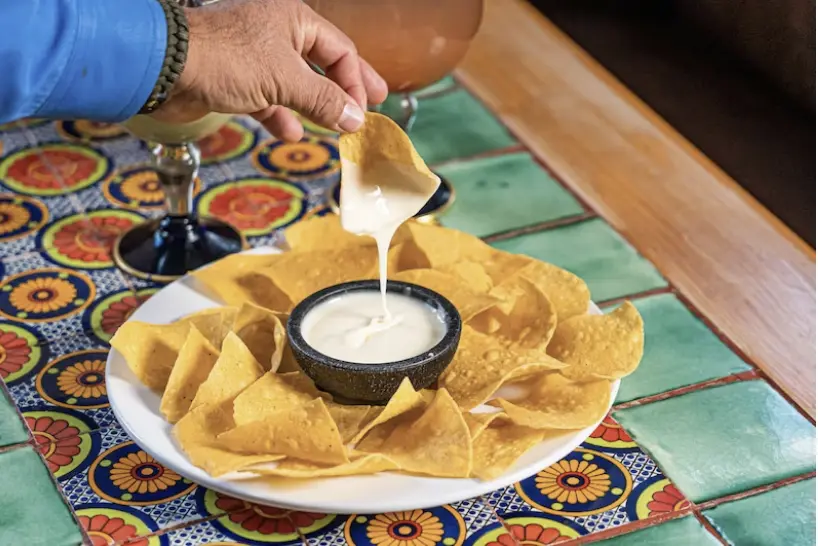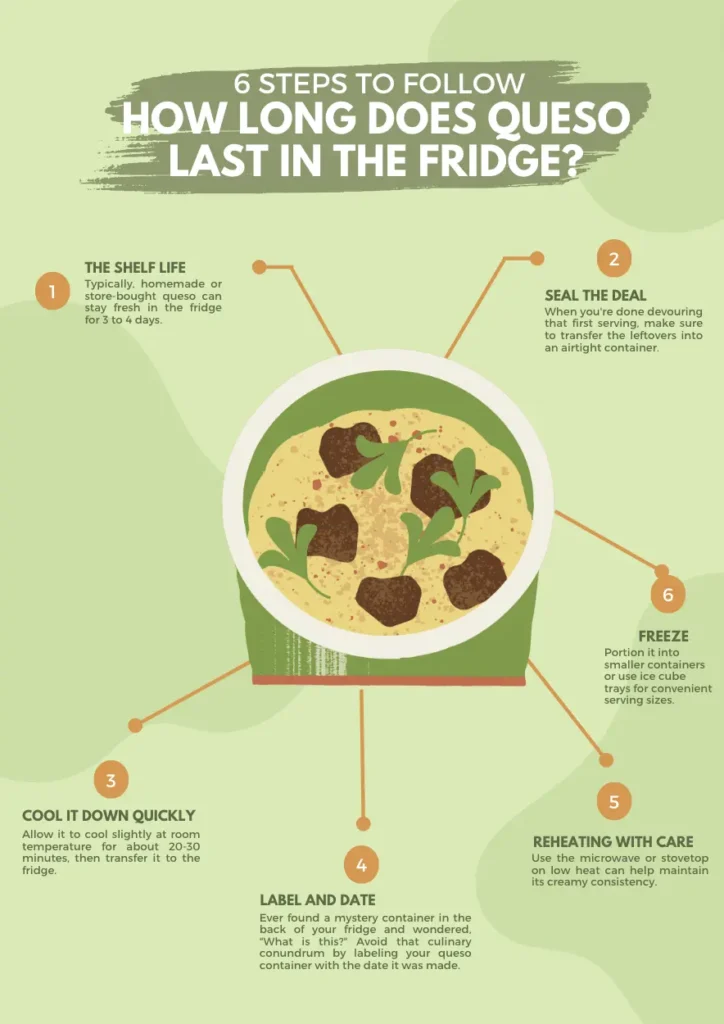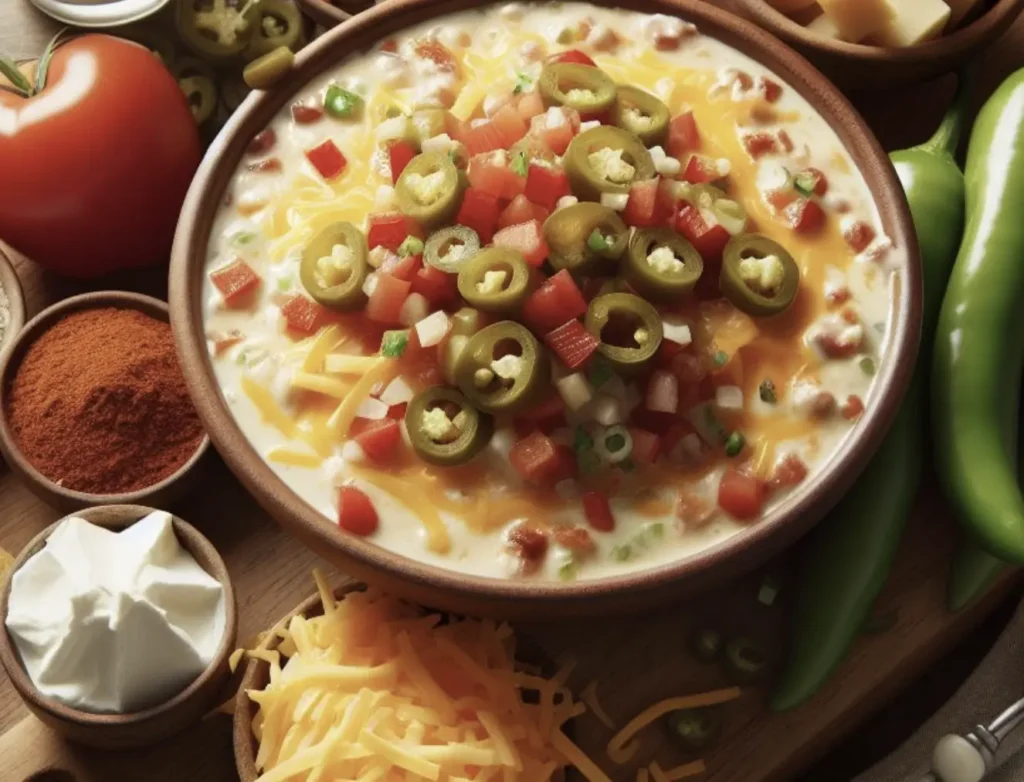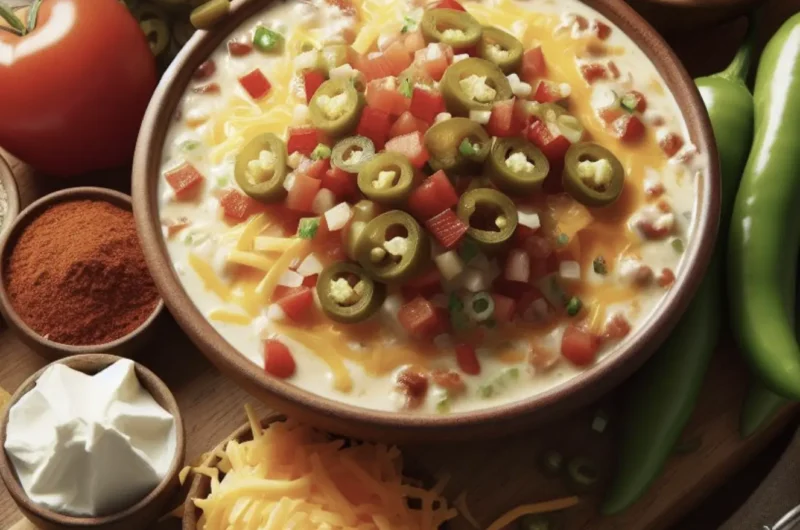Savor the Flavor: How Long Does Queso Last in the Fridge?
Do you have a soft spot for the creamy, cheesy goodness of queso? Well, who could blame you? Queso dip is a party favorite, a game-day essential, and a comfort food go-to. But if you’ve ever made a batch that’s just too much for one sitting, you might wonder: how long does queso last in the fridge, and how can you keep it tasting as amazing as the day you first dipped into it? We’ve got all the answers and tips to extend the freshness of your queso, PLUS we’ll share our favorite queso dip recipe! But, before we find out the answer to the question: how long does queso last in the fridge, we need to ask: what exactly is queso?
What is Queso?
Queso dip, also known simply as “queso,” is one of the most popular Mexican dishes that’s loved for its creamy, cheesy, and often slightly spicy flavor. It’s a classic appetizer or snack commonly served at parties, gatherings, and Mexican restaurants. The typical ingredients for queso dip include:
“I’ll have plain tortilla chips,” said no one ever!

Photo Credit: Olga Kozachenko
- Cheese: The primary ingredient, of course, is cheese. Common choices for the cheese in queso dip include:
- Cheddar: Sharp cheddar cheese or mild cheddar cheese is often used for a rich, cheesy flavor.
- Monterey Jack: This cheese has a mild and creamy taste, making it an excellent option for achieving a smooth texture.
- Queso Blanco: As mentioned earlier, queso blanco is a mild, white cheese that melts well and is frequently used in queso dip.
- Milk or Cream: To achieve a creamy consistency, many queso dip recipes call for milk or heavy cream. This liquid helps thin out the cheese and create a velvety texture.
- Spices and Seasonings: Queso dip gets its characteristic flavor from a variety of spices and seasonings, including:
- Chili Powder: Adds a smoky and slightly spicy flavor.
- Cumin: Provides earthy, warm notes.
- Paprika: Adds color and a mild, sweet flavor.
- Cayenne Pepper: For those who like it hot, cayenne pepper can bring some heat to the dip.
- Garlic Powder and Onion Powder: These two ingredients enhance the overall flavor profile.
- Jalapeños or Green Chilies: To give the queso dip a spicy kick, diced jalapeños or canned green chilies are often added. You can adjust the quantity to control the level of spiciness.
- Tomatoes: Chopped tomatoes can add a fresh, juicy element to the dip and balance out the richness of the cheese.
- Onions: Finely diced onions, whether white or red, can provide a mild, savory flavor and some textural contrast.
- Cornstarch or Flour (Optional): Some recipes call for a small amount of cornstarch or flour to help thicken the dip, especially if you want a slightly thicker consistency.
- Butter or Cooking Oil: A small amount of butter or cooking oil is sometimes used to sauté the onions, garlic, and spices before adding the cheese and other ingredients.
The exact combination of these ingredients can vary from recipe to recipe, and personal preferences often play a role in how spicy, creamy, or flavorful the queso dip turns out. Queso dip is typically served warm and is perfect for dipping tortilla chips, bread, vegetables, or even drizzling over nachos or tacos. It’s a crowd-pleasing favorite that’s hard to resist at any gathering or as a tasty snack. But how long does queso last in the fridge? We’re getting to that. But first, you should know the difference between homemade queso and restaurant queso.
Queso at Mexican Restaurants:
When you dine at a Mexican restaurant anywhere in the United States, ordering a side of queso is almost second nature. It’s a quintessential appetizer or accompaniment that often kicks off a memorable meal. Restaurant-style queso is known for its luscious, velvety texture and rich, cheesy flavor. What sets it apart from homemade queso is the expertise of the chefs who craft it. They have the culinary mastery to create a silky-smooth queso that keeps you coming back for more.

Photo Credit: Hybrid Storytellers
The restaurant experience also adds an element of social delight. Queso is typically served in a communal bowl, making it perfect for sharing with friends and family. It’s a conversation starter and a warm, communal bonding experience that’s hard to replicate at home.
Homemade Queso Fresco:
Homemade queso, on the other hand, offers the joy of personalization. You can tweak the ingredients and seasonings to your liking. Whether you prefer a spicier kick with jalapeños or a milder, creamier version, the choice is yours. Making queso at home allows for experimentation and the satisfaction of crafting a delicious dish from scratch.
While homemade queso might not always achieve the same silky-smooth consistency as the restaurant variety, it brings a comforting, rustic charm that’s uniquely its own. Plus, nothing beats the feeling of accomplishment when you serve your homemade queso to appreciative guests.
Mexican restaurants offer a wide range of queso dips, each with its own unique flavor profile and ingredients. Here are some popular types of queso dips you might find at Mexican restaurants:
- Queso Fundido: This indulgent queso dip is made by melting cheese until it’s hot and bubbly and then topping it with ingredients like spicy chorizo sausage, sautéed mushrooms, or roasted poblano peppers. It’s often served in a hot skillet, making it a fun and shareable appetizer.
- Chili con Queso: This classic queso dip combines melted cheese with diced green chilies and sometimes tomatoes. It’s typically served as a dip for tortilla chips and is known for its slightly spicy kick.
- Queso Blanco: Queso blanco, which means “white cheese,” is a smooth and creamy white cheese dip. It’s typically made with white American cheese or Monterey Jack cheese and flavored with spices, diced jalapeños, or green chilies for a mild heat.
- Queso con Spinach: This variation of queso blanco incorporates spinach, adding a touch of freshness and color to the dip. It’s a great way to sneak in some greens while enjoying your queso.
- Queso con Chorizo: Queso dip with chorizo sausage is a flavorful and hearty option. The spicy, crumbled chorizo adds a smoky and savory dimension to the creamy cheese dip.
- Queso con Guacamole: Some Mexican restaurants take queso to the next level by topping it with a generous scoop of guacamole. This combination of creamy avocado and cheese is a winning combination.
- Queso con Rajas: Rajas are strips of roasted poblano peppers, often sautéed with onions and served in queso dip. This variety provides a smoky and slightly sweet flavor to the cheesy dip.
- Queso con Carne: Queso dip with seasoned ground beef or shredded beef is a hearty and satisfying choice. It’s a meat lover’s dream, offering a blend of savory flavors.
- Queso con Tocino: Bacon lovers rejoice! This variation of queso dip features crispy bacon bits mixed into the cheesy goodness, adding a salty, smoky flavor.
- Queso con Frijoles: For a protein-packed dip, some Mexican restaurants combine queso with refried beans. This hearty queso dip offers a rich and creamy texture with a hint of bean flavor.
These are just a few examples of the delicious queso dip varieties you can enjoy at Mexican restaurants. Whether you prefer your queso with a spicy kick, a touch of freshness, or loaded with meats and vegetables, there’s a queso dip to satisfy every craving. But back to our question: How long does queso last in the fridge? Before we answer that, we must take a look at the main ingredient in queso dip: the cheese! What kind of milk is queso made from?
Is Mexican Cheese Made With Cow’s Milk?
Yes, Mexican cheese is typically made with cow’s milk, but it’s important to note that Mexico has a rich and diverse tradition of cheese-making, resulting in various types of cheese produced throughout the country. While cow’s milk is the most common base for Mexican cheese, there are also cheeses made from goat’s milk and sheep’s milk in certain regions. The type of milk used can vary depending on the specific cheese variety and the traditional methods of production in different Mexican states.
Some well-known Mexican cheeses made from cow’s milk include Queso Fresco, Queso Chihuahua, and Queso Asadero. Goat’s milk and sheep’s milk cheeses like Queso de Cabra and Queso de Oveja are also produced, particularly in regions where these animals are more prevalent.
While cow’s milk is the primary source of milk for many Mexican cheeses, the country’s cheese-making traditions encompass a wide range of milk sources and cheese varieties, contributing to the richness and diversity of Mexican cuisine.
Whether enjoyed at a Mexican restaurant or made with love at home, queso is a beloved side dish that adds an extra layer of deliciousness to any Mexican meal. Each style has its own charm, with restaurant queso offering a silky-smooth experience and homemade queso providing room for personalization.
And let’s not forget the exciting variety of queso options, each a delightful taste of Mexico’s culinary diversity. So, the next time you dip a chip into that creamy, cheesy goodness, savor the moment and appreciate the delicious world of queso.
So, How long does queso last in the fridge? For best results in storing queso and enjoying leftover cheese dip, follow these 6 steps:
- The Shelf Life: First things first, queso isn’t a forever friend in the fridge. But don’t fret; it can last quite a while. Typically, homemade or store-bought queso can stay fresh in the fridge for 3 to 4 days. After that, its quality might begin to degrade, and you might notice changes in taste and texture.
- Seal the Deal: The best way to keep your queso fresh is proper storage. When you’re done devouring that first serving, make sure to transfer the leftovers into an airtight container. Whether it’s a glass jar or a plastic container with a tight-fitting lid, sealing out excess air is crucial to prevent the queso from absorbing unwanted odors and flavors. Plastic wrap can be used in a pinch, but be sure to wrap it tightly and remove as much of the air as possible. Aluminum foil should not be used, as it doesn’t provide a tight enough seal.
- Cool It Down Quickly: After your queso is ready, don’t leave it out at room temperature for too long. Bacteria can multiply rapidly in warm temperatures, so refrigerate it promptly. Allow it to cool slightly at room temperature for about 20-30 minutes, then transfer it to the fridge.
- Label and Date: Ever found a mystery container in the back of your fridge and wondered, “What is this?” Avoid that culinary conundrum by labeling your queso container with the date it was made. This way, you’ll know exactly when it’s time to say adiós.
- Reheating with Care: When it’s time to enjoy your leftover queso, reheat it gently. Using the microwave or stovetop on low heat can help maintain its creamy consistency. Stir occasionally to distribute the heat evenly.
- Freeze for the Future: If you’re worried you won’t finish your queso within 3 to 4 days, consider freezing it. Portion it into smaller containers or use ice cube trays for convenient serving sizes. When you’re ready to enjoy it again, simply thaw it in the fridge overnight and reheat as usual.

It’s essential to ensure that your queso dip is safe to eat to avoid any foodborne illnesses.
Here are some signs that your queso dip may have spoiled in the fridge:
- Off Odor: If your fresh homemade queso dip has a sour smell or unpleasant smell, it’s a strong indicator that it has gone bad. Spoiled queso may emit a sour, rancid, or foul odor.
- Mold Growth: Visual inspection is crucial. If you notice any visible signs of mold on the surface of the queso dip or anywhere inside the container, it’s a clear indication that it’s no longer safe to eat.
- Unusual Texture: Fresh queso dip should have a creamy and smooth texture. If you see any separation, curdling, or a grainy texture, it’s a sign that the dip has deteriorated.
- Change in Color: Queso dip is typically a creamy white or yellowish color, depending on the cheese used. If you observe any significant changes in color, such as a green or blue tint, it’s a red flag.
- Watery Separation: Sometimes, when queso dip begins to spoil, it can release excess moisture, leading to a watery separation and a slimy texture at the bottom of the container. If you notice this separation, it’s best to discard the dip.
- Excessive Sourness: While queso dip may have a slightly tangy flavor due to the cheese and spices used, an excessively sour or acidic taste is a sign of spoilage.
- Gas or Bubbles: If you open the container of queso dip and hear or see bubbles or gas escaping, it’s a sign of bacterial growth, and the dip may be unsafe to consume.
- Expired Date: If you have a store-bought queso dip and it has passed its “use by” or “best before” date, it’s a good idea to err on the side of caution and not consume it, even if it appears fine.
- Extended Storage Time: Even if your queso dip doesn’t show visible signs of spoilage, it’s important to consider how long it has been in the fridge. If it has been stored for longer than the recommended safe storage time (usually 3-4 days for homemade queso), it’s safer to discard it.
If you notice any of these signs, it’s best to play it safe and avoid consuming the queso dip. Consuming spoiled food can lead to food poisoning, which can range from mild discomfort to severe health issues. When in doubt, it’s better to discard the queso and prepare a fresh batch.
How Long Does Tostitos Queso Last Before it’s Opened? After it’s Opened?

Photo Credit: Hybrid Storytellers
Tostitos Queso or Tostitos Salsa Con Queso, like many other commercially packaged store-bought queso fresco cheese dips and products, typically comes with both a “Best-By Date” or “Use By” date printed on the packaging and a recommendation for how long it can be safely stored after it’s been opened.
Here are some general guidelines for store-bought nacho cheese sauce or basically any type of cheese dip:
- Before It’s Opened: Before opening, Tostitos queso should last until the expiration date printed on the dip container. It’s important to note that this date is a quality indicator, and the product may still be safe to eat for some time after that date if stored properly and if the packaging remains intact.
- After It’s Opened: Once you’ve opened the container of Tostitos queso, it’s essential to refrigerate it promptly. Typically, an opened container of queso dip, including Tostitos queso, can be safely stored in the refrigerator for about 3 to 4 days. However, always check the product label for specific storage recommendations, as they may vary by brand or product.
Remember that these are general guidelines, and the actual shelf life of Tostitos dip can vary depending on factors such as the temperature of your refrigerator, the condition of the packaging, and the specific ingredients used in the product. To ensure the safety and quality of the queso dip, it’s best to adhere to the storage recommendations provided on the packaging. If you have any doubts about the safety or freshness of the queso dip, it’s better to discard it to avoid any potential foodborne illnesses.
Queso is a crowd-pleaser that can light up any gathering. But to keep that cheesy goodness and optimum flavor, proper storage and a few tips are essential. Now that you know the answer to the question: how long does queso last in the fridge, you can savor every creamy, cheesy bite without any worries.
So, the next time you whip up a batch, enjoy it to the fullest, and remember these tips to store the delicious dip to make your queso last longer and taste even better!
FAQS
How Long Can You Keep Queso in the Fridge?
Fresh Homemade Queso
- Duration: 3-4 days
- Tip: Store in an airtight container
Store-Bought Queso
- Unopened: Check expiration date
- Opened: 5-7 days
- Tip: Keep it in its original jar if possible
| Queso Type | Shelf Life | Storage Tips | Reheating Advice |
|---|---|---|---|
| Homemade Queso | 3-4 days | Airtight container, refrigerate | Low heat, stir often |
| Store-Bought (Unopened) | Check label | Original packaging, refrigerate | Low heat, stir often |
| Store-Bought (Opened) | 5-7 days | Airtight container/original jar, refrigerate | Low heat, stir often, add milk/water if needed |
How Long is Leftover Cheese Dip Good For?
Homemade vs Store-Bought
- Homemade: 3-4 days
- Store-Bought: Up to 7 days after opening
- Key Factor: Absence of preservatives in homemade queso shortens its shelf life
Signs of Spoilage
- Smell: Sour or unpleasant odor
- Texture: Lumpy or watery consistency
- Color: Any discoloration or mold growth
How Do You Store Leftover Queso?
Storing Tips
- Airtight Containers: Essential to prevent contamination and odor absorption
- Refrigeration: Always keep it refrigerated at or below 40°F (4°C)
- Avoid Cross-Contamination: Use clean utensils every time
- Portioning: Store in small portions for easy reheating
Additional Tips
- Labeling: Date the container to keep track
- Freezing: Not recommended due to texture changes upon thawing
Can You Save and Reheat Queso?
Reheating Tips
- Method: Microwave or stovetop
- Low Heat: Prevents separation and burning
- Stirring: Frequently stir for even heating
- Consistency: Add a splash of milk or water if too thick
Safety Reminder
- Reheat Only Once: Repeated reheating increases the risk of foodborne illness
- Temperature Check: Ensure it reaches 165°F (74°C) to kill harmful bacteria
favorite queso blanco dip
Course: AppetizersCuisine: MexicanDifficulty: Easy4
servings20
minutes15
minutesA creamy and mildly spicy Queso Blanco dip, perfect for dipping tortilla chips, nachos, or fresh vegetables!
Ingredients
12 ounces (about 3 cups) of white American cheese, shredded or cubed
4 ounces of Monterey Jack cheese, shredded (for extra creaminess)
1 cup whole milk
1/2 cup diced green chilies (canned or fresh)
1/2 cup diced tomatoes (canned or fresh)
1/4 cup finely diced white onion
1-2 cloves garlic, minced
1/2 teaspoon ground cumin
1/2 teaspoon chili powder (adjust to taste for spiciness)
1 tablespoon vegetable oil
Salt and pepper to taste
Chopped fresh cilantro (for garnish, optional)
Sliced jalapeños (for garnish, optional)
Directions
- Prepare Ingredients: Shred or cube the white American cheese and Monterey Jack cheese. Dice the green chilies, tomatoes, and white onion. Mince the garlic.
- Sauté Onion and Garlic: In a medium-sized saucepan, heat the vegetable oil over medium heat.
- Add the diced onions and minced garlic. Sauté for about 2-3 minutes until they become translucent and fragrant.
- Add Green Chilies and Tomatoes: Add the diced green chilies and tomatoes to the saucepan. Cook for another 2-3 minutes, stirring occasionally.
- Melt the Cheese: Reduce the heat to low and add the shredded or cubed white American cheese and Monterey Jack cheese to the saucepan.
- Pour in the milk gradually, stirring continuously to help melt the cheese evenly. Continue to cook and stir until the cheese is completely melted and the mixture is smooth and creamy. This may take about 5-7 minutes.
- Season the Dip: Stir in the ground cumin and chili powder. Season with salt and pepper to taste. Adjust the amount of chili powder to achieve your desired level of spiciness.
- Serve: Transfer the queso dip to a serving bowl. If desired, garnish with chopped fresh cilantro and sliced jalapeños for added flavor and color.
- Enjoy: Serve the Queso Blanco dip immediately while it’s hot and creamy, along with tortilla chips, nachos, or your favorite dippable items.
Notes
- Adjust the level of spiciness to suit your preferences, and feel free to get creative with additional toppings like diced avocado or crumbled queso fresco.
Craving more delicious recipes? Try these: Honey Cinnamon Espresso Latte

